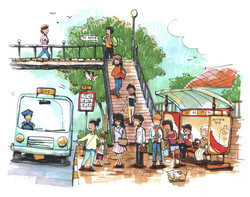Time to get on board with the social impacts of transport disadvantage
In addition to the financial aspect, various cultural, social, political and physical factors lead to so-called transport-related social exclusion (TRSE), with wide-reaching implications for certain population groups. TRSE refers to individuals who have limited opportunities with regard to everyday activities due to a lack of necessary transport resources. The project TRANSENDANC (Transport and social exclusion: New directions and national comparisons) sought to better comprehend this link in both developed and developing countries. A primary goal was to develop a network of researchers and policymakers to examine transport and social exclusion in different national contexts and help translate knowledge to improved policy practices. To share their experiences and knowledge on TRSE, researchers from universities in Belgium, Chile and the United Kingdom took part in a high-level, multidisciplinary collaboration. They worked toward a deeper understanding of TRSE by considering the connections between financial hardship, access issues and low social capital in different geographical contexts. The team produced a literature review underlining transport disadvantage, social exclusion and social capital as three core components (and entwined processes) of TRSE. A review of a large set of potential indicators helped outline potential interactions of these three core components and the creation of a set of indicators for their measurement. Included in this work was the development of a composite mobility/participation index based on six indicators. Researchers carried out an empirical analysis using data sets already available for the project's case study cities: Ghent (Belgium), Los Ángeles (Chile) and Merseyside (United Kingdom). The work points to a complex interplay between an individual's personal attributes, capabilities and responsibilities and the spatiotemporal opportunities available to them in their respective cities. Another area of investigation, particular to selected neighbourhoods in Concepción, focused on the role of social capital and social networks. A quantitative analysis showed that low-income households experienced some transport disadvantage when accessing social support. Qualitative follow-up interviews picked up on issues potentially impacting mobility and the maintenance of social networks. TRANSENDANC studied the relationship between people's socioeconomic disadvantage and their travel behaviour, advancing socio-theoretical explanations of related outcomes. Project work has heightened awareness of TRSE and more comprehensive research on the topic should help to level the playing ground for a more equitable society.



